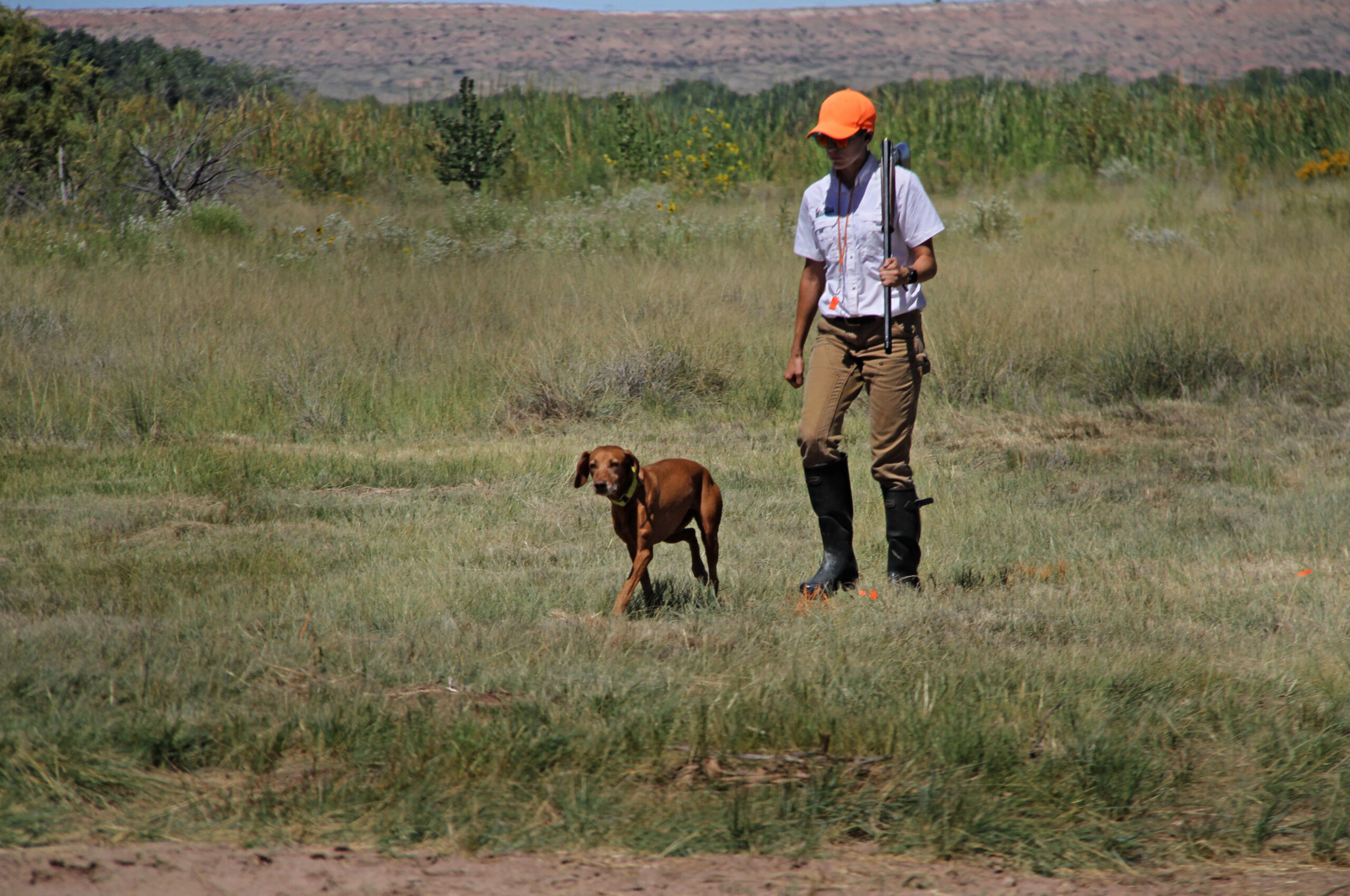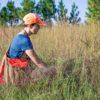This summer, Zara and I trained for the NAVHDA Invitational, which is NAVHDA‘s premier hunt test. In order to run at the Invitational, your dog has to receive a Prize 1 in the Utility test in the year prior. The Invitational takes the Utility tasks to another level. Dogs have to run an hour in the field with a bracemate, do a 100 yard blind retrieve across water, complete a double marked retrieve in a pond, heel off-leash, and honor another dog’s duck retrieve.
Going into it, you know that the odds are against you. On average, only about 40% of the dogs pass each year. This year, in New Mexico, only 30% passed. This post is not titled “How to Pass the NAVHDA Invitational,” because Zara and I did not pass this year. There’s also an element of luck to events like this in regards to things that you can’t control, so passing is never a guarantee. However, having been there, I have a much better idea of what it takes to pass.
What It Takes to Pass the Invitational
I’m going to break this post down into each section of the test, but the overarching message is the same for all parts. If you want to have the best chance of passing, I believe you have to do as much as you can to prepare. That probably sounds obvious, but you need every possible tool in your toolbelt. You need to train every scenario you can think of and proof your dog as much as you can.

My bracemate and I talk to the judges before we start the field portion of the Invitational. Photo by Waylon Lunn.
Fieldwork
Invitational-level field work is similar to Utility-level field work in that the dogs need to hunt effectively, point staunchly, be steady until release to retrieve a bird, and retrieve to hand. In the Utility test, stopping to flush is not required, but it is at the IT level. Since your dog is running with a bracemate (another dog), they are also required to stop and back the bracemate when it goes on point and stand through its retrieve. The field portion is also a full hour, whereas it is only 30 minutes at the Utility test.
Backing/Honoring
Your dog must back its bracemate if you want to pass the Invitational and you cannot command them into a back. This is one of the factors that knocks a lot of dogs out. Zara does not like to back other dogs and has tried to avoid it in the past. I spent A LOT of time working on backing this summer because of the issues we were having. Thankfully, our hard work did pay off and she did back her bracemate at the IT. I would run as many braces and do as many training scenarios as you can think of in order to create a dog who backs no matter what. Here are some ideas:
- Running with as many breeds as possible (shorthaired, longhaired, small dogs like French brittanies, and dogs that blend into the cover). You can consult the list of breeds who will be running on the same day as you a few months before the test.
- Dogs that do not look staunch/wag their tail while pointing. This is sometimes the case with small munsterlanders.
- Dogs that false point. Have your dog back a dog after it has false pointed. You can set this up by giving the bracemate a “whoa” command where there’s no birds.
- Dogs that sit or lay down on point
- Dogs that are not steady / chase the bird / take out the bird
- Running a 3 or 4 dog brace. This will give your dog extra practice with backing. Make sure your dog is ready for this level of pressure before you try it.
Steadiness
In New Mexico this year, the cover was a lot different than what many people and their dogs were used to. It was certainly the first time Zara had ever hunted in anything like that. Because the cover was very sparse in places, there were a lot of running birds. From looking at the scores, steadiness was one of the main things that caused dogs not to pass. I would think about training for the following scenarios:
- Running birds
- Coveys of birds
- Wet birds / training in the rain
- Backing dog getting the retrieve
- Walking a long way in front of your dog to flush and making them wait until you get back to retrieve
- Missed shots
- Having the dog point birds that are visible
- Stop to flush birds that are shot and retrieved
- When two birds are shot at the same time (double mark on land)
Retrieving
While the standards for retrieving shot birds are basically the same as they are in the Utility test, I would highly recommend having your dog steady enough so that they wait for you to walk back to them after a flushing a bird and tap them on the head to retrieve. During field trial season last year, I had gotten into the habit of allowing Zara to retrieve on a verbal “fetch.” I would walk in front of her, flush the bird, and after the gunners shot it, I would look back at her and say “fetch” after a short pause. I did not walk back to her or make her wait. As a result, she was ready to break as soon as anyone said anything after a bird was shot. This came back to bite me at the National Gun Dog Championship and we got picked up because of it. After that trial, I vowed to never have that happen again and I spent a lot of time this spring/summer making sure she was steady until I touched her.
In training with bracemates and in situations at the Invitational, I realized how important and helpful this is. Sometimes, because of the way the cover is or the way the dog is running, the backing dog ends up very close to the pointing dog. When the bird is shot, if the pointing dog’s handler says “fetch” in a normal tone of voice, the backing dog may be tempted to retrieve. In the photo below, you can see how close the GSP is to Zara. I actually never said any verbal commands to get Zara to retrieve during our field run. I simply tapped her on the head. This is good etiquette and I would recommend training to this level.

Zara’s bracemate, a black German shorthaired pointer, backs her point. Zara ended up having only one back at the Invitational, at the very end of her run. Photo by Waylon Lunn.
The Blind Retrieve
The blind retrieve was the only task that was really new to Zara this summer. As such, I spent months building a foundation on land before switching to water. I will do a post on how we trained at a later time. This was the event that disqualified us at the Invitational. The way that the blind was set up was different than in previous IT locations and in places we trained. Instead of it being a straight channel of water, there was a cut out area where you sent the dog from. As a result, there were close areas of reeds to the left and right that looked very inviting to the dogs. When we tested, there was a strong wind blowing left to right. Zara kept going left and I couldn’t get her to go straight across to get the duck. I had heard from people the previous day that there were live ducks in the area, so that could have been what she was smelling.
If I train for the IT again, I will also make sure to train with live ducks around. I will also try to practice on a day with a strong wind, although that can be hard to arrange.
For the blind retrieve, you’ll definitely want to practice in as many new water areas as possible. If you use the same pond twice, it’s not a true blind. It’s fine to do that, but you’ll want to seek out a variety of ponds and channels. I tried to vary the distance. Once she was comfortable going a longer distance, I would alternate with a shorter distance. So one day we might do a 90 yard blind, followed by a 50 yard blind the next day. Then we’d do a 100 yard, then a 65 yard. This kept it interesting and allowed her to build confidence on the shorter ones.
When I talked to other people who have gone to the IT in the past, they recommended teaching “casting commands.” In an ideal situation, your dog goes straight across the water on one command and gets the duck. However, you are able to give extra commands (verbal, hand, or whistle) while your dog is at a distance from you if they need help to locate the duck. If they take the commands, you can still get a passing score.
I listened to Episode 132: Handling 101 (Force Fetch 5) of the Gun Dog It Yourself podcast before I started teaching casting commands to Zara. I found Bob Owens’ description very thorough and helpful. I spent a good amount of time working on casting commands on land and Zara had a decent handle on them. But I never put in the time to transition them to water. This was a conscious decision I made – with everything else that I had to work on, it was just going to be too much to fit it in. I knew I might regret it, and if I had had the ability to cast her at the IT this year, we likely would have passed. If we go again, I will absolutely proof casting commands on water. While in many situations you won’t need them, you can never predict the weather or the dog’s behavior that day. It’s better to have them and not need them than vice versa. I tried to give Zara a casting command at the IT this year, but she didn’t take it. If she did, we may have passed.

Training for the blind retrieve this summer. Getting your dog positioned correctly and sending them on a straight line is important. Photo by Kim Hauck.
Honor by Blind
This exercise seems relatively simple at first glance. You walk your dog up to a designated spot, give them one stay or whoa command and stand behind them at a distance. A dead duck is throw into the water in front of them and a blank shot is fired. Then another dog retrieves the duck in front of your dog. The testing dog just needs to stay there until the handler returns to it. After a few repetitions of this, Zara had gotten the idea and didn’t break when the other dog retrieved. However, two of the other NAVHDA members I trained with this summer recommended doing an exercise to proof this honor. They got the idea for this from a long-time NAVHDA member whose dog failed the Invitational one year during the honor by the blind.
The point of the exercise is to get the dog to break its stay and try to go after the duck. Once it breaks, the handler gives it a strong correction on the e-collar to ensure that it learns not to break again. When we did this with Zara, we had several people help out. The volunteers threw ducks into the water and fired shots until Zara moved. It was a bit crazy. There were probably at least four or five ducks being thrown and at least as many shots. The retrieving dog just kept retrieving over and over. When Zara finally moved, I said “WHOA” and gave her a momentary nick on the e-collar at a high level. Then she stayed there until the retrieve was complete and I heeled her off.
When selecting a level on the e-collar, I used a higher level than I had ever used on her, but it was not as high as the collar goes. I used an 8 and the collar goes up to 18. I normally use level 4 or 5 if I need to correct her in the field. She will respond to a 1 or 2 when she’s not amped up. I chose to use level 8 for this exercise because it would get the point across but not be so high that it would shut her down. A momentary nick is also much less impactful than the continuous stimulation. I felt like Zara could handle this exercise which is why I did it. However, this may not be suitable for every dog.
We did the honor by the blind a few times after this proofing exercise and she did not try to move again. We got a “4” on this at the Invitational. For this portion of the test, it’s also helpful to have a variety of dogs retrieve ducks in front of your dog, especially dogs that drop the duck or will walk right by your dog.
Zara practices the honor by the blind sequence this summer.
Double Mark/Heeling
The double mark retrieve is a modification on the Utility-level steady by the blind sequence. There are a couple of considerations to train for this exercise. You must make sure that your dog always retrieves the “wiper” bird first – this is the second duck that is thrown into the water. If they don’t, training is a good time to redirect or correct them. It’s a good idea to train on windy days so that the “long” bird moves. When I observed the 2021 Invitational in Iowa, it was quite windy. That long duck moved quite a bit, which caused some of the dogs to struggle. You should definitely train with decoys in the pond (since they’re present at the test), especially decoys that are in line with the long bird.
The double mark sequence involves off leash heeling to and from the water. Heeling is something that is sometimes easy to overlook. It seems so basic and I, for one, don’t really enjoy practicing it. However, it’s worth putting the time in to make sure that your dog has a reliable off leash heel even during high levels of distraction. I would recommend practicing heeling as many places as you can. For Zara, I found that she heels well in a lot of locations, but when we get into a test environment, it’s hard for her to focus. She wants to walk ahead of me. Even though we did a lot of heeling, I specifically sought out places where I knew she would be very amped up. This was mainly at NAVHDA training days. One day this summer, I practiced heeling her back and forth next to the duck search swamp. She definitely wanted to go get a duck, but she had to pay attention to me instead. Even so, our heeling was not perfect at the IT.

Zara and I heel up to the double mark at the NAVHDA Invitational. Note how she is not really right next to me. We got a 3 in heeling as a result. The highest score is a 4. Photo by Nancy Anisfield.
Other Considerations
This post is getting long, so I’ll keep this section short. There’s a lot to train for prior to the NAVHDA Invitational, but make sure you don’t overlook conditioning and heat tolerance. I spent time this summer running Zara off leash and making her swim to ensure that she had the endurance to run an hour in the field and do multiple long swims. We also practiced in warm temperatures, with caution. Since the Invitational is held in early/mid September, it’s usually quite warm. If your dog is doing a field run in the afternoon, it could be more than 80 degrees. Thankfully, there are multiple tubs of water in each field and the judges let you spend plenty of time cooling off your dog. But it’s important to make sure they can handle hot weather.
Have you trained for the NAVHDA Invitational? Are there any other things you’d recommend doing? Let me know in the comments below.



